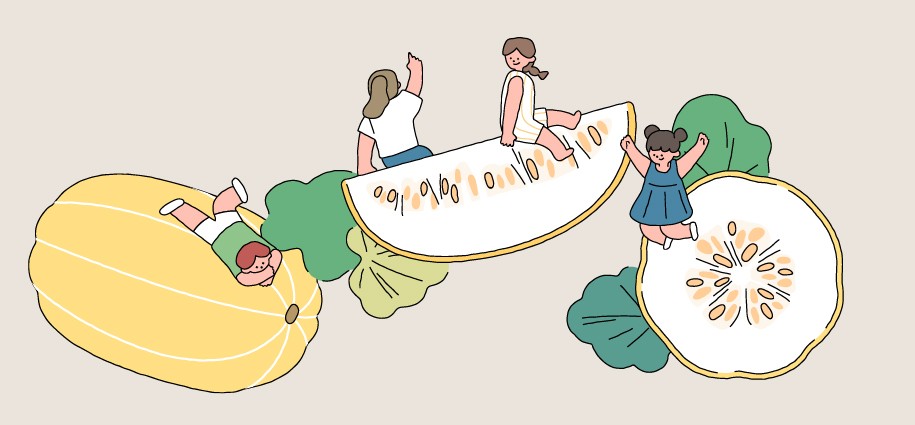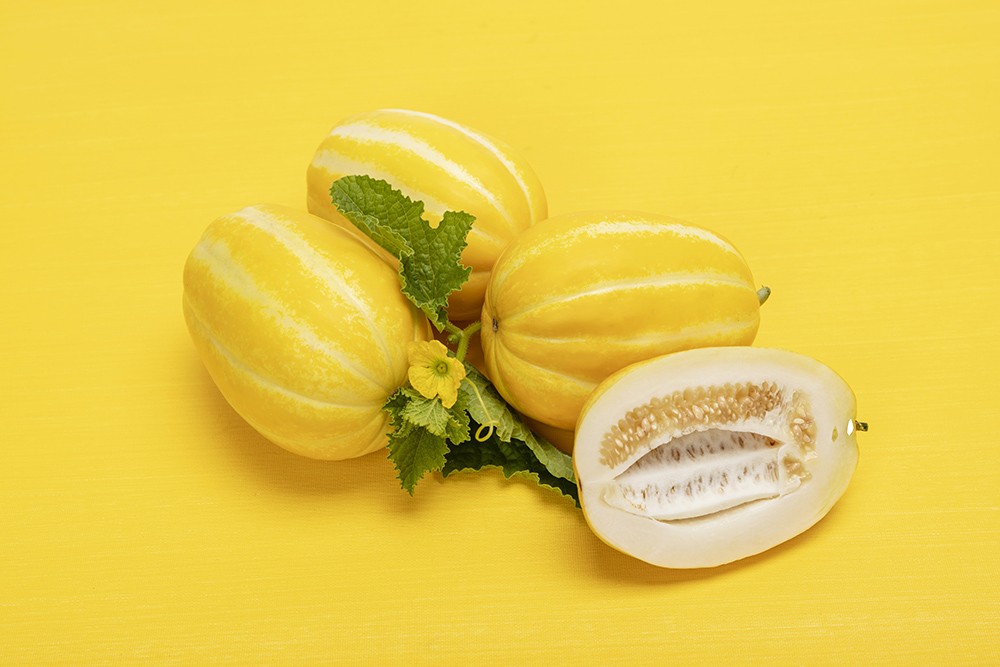한식 읽기 좋은 날
Vol 52. Soil, the Foundation of HANSIK
Stories about the Chamoe
HANSIK at the Sayings
The chamoe is a fruit that ripens in June, when the temperature really begins rising. Well-loved for its unique fragrance and sweet flavor, the chamoe is the subject of many sayings, most of which are about its taste. Let’s explore the linguistic references and wealth of stories that are linked to this delicious melon.
Article Noh Yunyoung (Editorial Team) Sources Encyclopedia of Korean Folk Culture, Wikipedia

A uniquely Korean fruit
The chamoe is an annual climbing plant that is part of the gourd family. It is believed to have originated in the Southern Sahara and is today grown (in limited quantities) in China, Iran, Turkey, and India. Called “Korean melon” in English, it is overwhelmingly grown in Korea. The main stem grows outward and can “climb” upward by attaching to other objects with tendrils. The leaves grow staggered on the stem, are hand-shaped, and have tiny thorns at the edges.
The chamoe is a fruit: botanically speaking, a ripened flower ovary that contains seeds. Like the watermelon, strawberry, and tomato, the chamoe is a tuberous plant that is grown in gardens. It has sweet, mild-tasting flesh and seeds that are edible.
The chamoe adapts to diverse climates but grows best in a hot, dry climate with an average temperature of 30 degrees Celsius. The elliptical chamoe, which turns a darker yellow as it ripens, grows in Korea in the summer but can now be enjoyed year-round due to greenhouse cultivation. It has a crunchy flesh and sweet juice that are beloved by all ages.
There are several theories on the chamoe’s origin. Some argue that it is a modified version of a wild Indian melon; others say that it came from northern China. Chamoe is believed to have entered Korea during the Three Kingdoms period or slightly earlier. History of Ancient Korea and History of Goryeo include mention of chamoe in association with the Unified Silla period.
There are several breeds of chamoe: Seonghwan chamoe and Gangseo chamoe are the highest-quality, with Gam chamoe and Sagwa chamoe being cultivated widely. Euncheon chamoe, the variety that is grown in Japan, is grown the most widely because of the popularity of its firm, sweet flesh.
Sayings inspired by the deliciousness of the chamoe
Having been popular with Koreans for centuries, the chamoe is mentioned in many metaphors and maxims. The most frequently-used phrase is “running around in a chamoe field,” which compares someone having snuck into a neighbor’s chamoe field to steal some ripe fruit to a person who is aggressive and reckless. It is suggested that the individual is in such a hurry to cut the chamoe from its stem because it tastes so good.
The expression “chamoe merchant in a dust-filled land” refers to someone who is invaluable in adverse circumstances, while “a large and sweet chamoe” is used to describe an object that has caught one’s eye because it is both beautiful and practical. On the other hand, the expression “no chamoe is both big and firm” means that there is no situation that is completely perfect. The saying “throwing away a chamoe to eat a pumpkin” refers to abandoning a frugal wife to take a concubine: in other words, discarding something valuable for something of poor quality. The expression “would not take a chamoe from the final days of monsoon season even if it is given for free” refers to an unfair transaction in which one is presented with an empty shell after the other person ate the sweet flesh for himself. During the summer monsoon, extremely heavy rainfall reduces the sweetness of fruits—a rule that also applies to the chamoe. It suggests that the lack of sweetness caused by heavy rain is worse than chamoe that has rotted in the rain.
As we can see, sayings featuring the chamoe have one thing in common: the fact that ancient Koreans regarded it as a delicious and perfect fruit, most likely due to its high caloric content and abundance of vitamins.

The chamoe’s many benefits
The chamoe’s glucose and fructose are quickly absorbed by the body, which helps alleviate fatigue. The large amount of beta-carotene, a natural antioxidant, makes the chamoe effective in preventing cancer and heart disease. The chamoe is 90 percent water and rich in vitamin C, which is why it relieves summertime thirst and replenishes the body’s fluids that are lost through sweating. It is also alkaline, thereby helping maintain the body’s pH balance in the summer, when excessive sweating can easily make the body acidic. The chamoe’s potassium acts as a diuretic, helping expel wastes that have built up in the body. Most of all, the chamoe has the highest amount of folic acid (a substance that ensures healthy fetal growth by preventing damage to the fetus’ nervous system and boosting the mother’s ability to produce blood) among fruits: someone who is pregnant only needs to eat one chamoe a day. The chamoe is also known to improve sperm function and help prevent dementia.
When purchasing chamoe, it is best to choose ones that are small and have fragrant-smelling rind. The freshest and most delicious chamoe are a rich yellow in color and have deep white lines and a thin stem. One thing to be careful of is that the chamoe is cold, according to the idea of “hot” and “cold” food in Oriental medicine, meaning that eating too much at once can give you a stomachache. Those with a kidney disorder who need to strictly regulate their potassium intake are also recommended to be cautious about eating chamoe.
Chamoe is usually eaten raw after removing the skin or cut into thin pieces for salad. Chamoe can also be used for many other foods, including kimchi, juice, and jangajji (pickled foods). Its freshness makes it perfect for those who have lost their appetite due to the summer heat. Many choose to remove the taejwa (soft part attached to seeds), but it is actually best to eat it with the flesh because of its high folic acid content.










